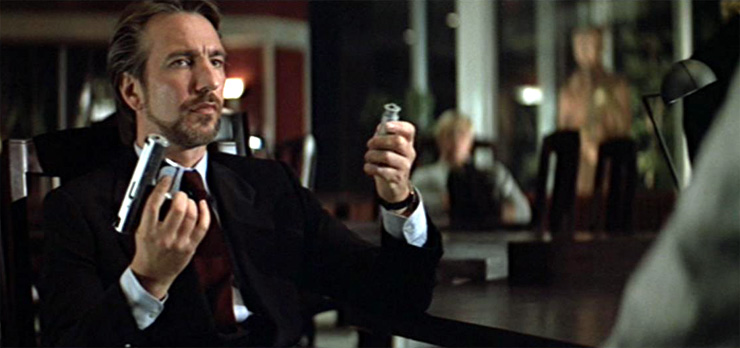
I debated whether or not to continue with this series of posts given all of the other things that are going on right now. The universities and public schools are sending students home, businesses are forced to shut down, the economy is teetering, people are panic-buying toilet paper of all things, and new cases of coronavirus are appearing at alarming rates pretty much everywhere.
I wouldn’t call these entries, running lists of past terrorist events, much of a diversion. But for me, writing this, and maybe for you reading it, this is a better use of my time than obsessively reading all of the bad news.
So I want to keep things this week on a relatively lighter note, and that means terrorism at the movies! For my money, the single most entertaining terrorist in recent film history has to be Hans Gruber, of Die Hard fame, the smoothly elegant leader of the “Volksfrei” movement, a left-wing West German terrorist group, played by the late, great Alan Rickman.
Of course, if you’ve seen the movie (who hasn’t?) you know it’s all a scam. Volksfrei isn’t a real group, the gang Gruber leads isn’t politically motivated at all (such a motivation central to any good definition of terrorism), and their demand for the release of “revolutionary brothers and sisters” imprisoned around the world in exchange for hostages is just cover for the real plan, the heist of some $640 million in “negotiable bearer bonds” from the safe of Nakatomi Plaza.
If you’d like to read more about my favorite movie terrorist and his plan to retire, “sitting on a beach earning 20 percent,” take a look at this appreciation from the online platform Medium. For a more academic take on Hollywood’s changing take on terrorism from the 1970s to the 2010s, give this piece, from the journal Perspectives on Terrorism, a read. Here’s a quick sample from the article:
When reviewing Hollywood’s output on terrorism, it is obvious that it correlates with the waves and historical development of political violence: previously sporadic encounters with terrorism in Hollywood cinema, like Alfred Hitchcock’s Saboteur (1942), became more frequent in the 1970s, at a time when international terrorism and especially hijackings of jetliners orchestrated by Palestinian groups made headlines and featured in newsreels. Thus, the Arab gunman, who threatens innocent passengers and strikes at Western installations, became a typical Hollywood villain …
And now on to this week’s look back.
- March 16, 1985 — Beirut, Lebanon: Journalist Terry Anderson is kidnapped off the street in Beirut and held hostage by Hezbollah. He was released more than six years later, in December 1991.
- March 17, 1978 — Maghera, Northern Ireland: David Jones, a British soldier working undercover, is killed during a gun battle with the Irish Republican Army.
- March 17, 1992 — Buenos Aires, Argentina: A car bomb destroys the Israeli embassy, killing 28 and wounding more than 200. Hezbollah claims responsibility.
- March 20, 1995 — Tokyo: Aum Shinrikyo releases sarin nerve gas in the Tokyo subway system, killing 12 and sickening more than 5,000.
- March 22, 2017 — New York City: James Harris Jackson, 28, is arrested after he turns himself in at a Manhattan police precinct where he confesses stabbing Timothy Caughman, 66, to death with a “Roman short sword” on a city street on March 20 after traveling to New York City to allegedly hunt and kill black men. He tells police the attack was a “trial run” for a series of killings he intended to carry off in order to deter white women from dating black men.